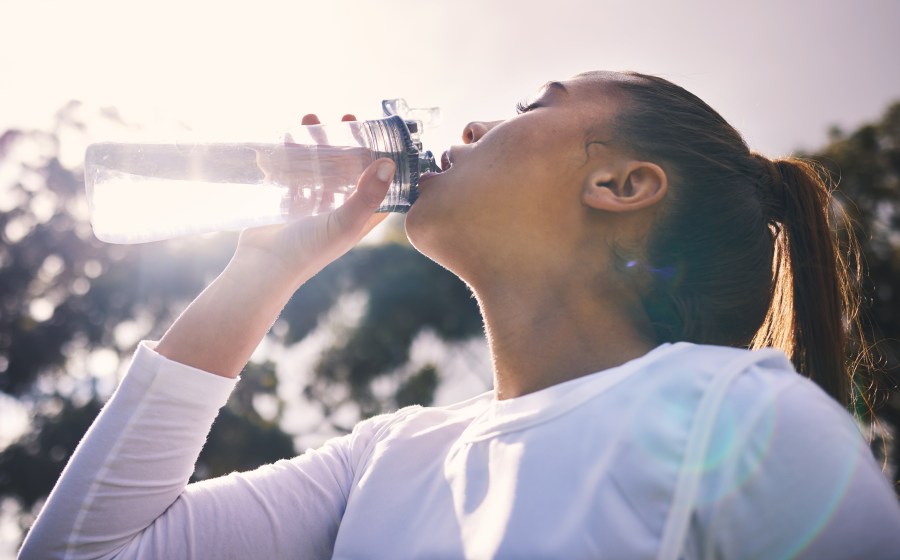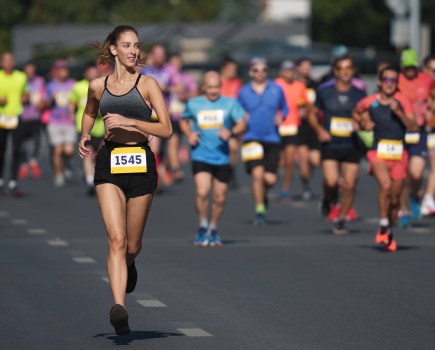Running in the summer is almost guaranteed to make you break a sweat, but do you know how to stay hydrated when you train? Read on…
Water is essential for your body to function. You are around 65 per cent water, and water is necessary for everything from blood volume and heat regulation, to the digestion and absorption of the food you eat. You lose fluid all the time – as water vapour in your breath, through your skin as sweat and through excretion. And, as you exercise, especially at high intensities and in warm conditions, fluid losses increase.
Drinking to replace your fluid losses is something you do instinctively throughout your life. But when it comes to sport and exercise, the messages around how much you should drink, and the content and composition of that liquid, can seem pretty complicated. So what, and how much, should you be drinking, and do you know how to stay hydrated?
Training tips
Until relatively recently, the theory was you should be drinking as much water as possible, and that your sensation of thirst is an unreliable indicator of your hydration status. Drinking a magic eight glasses of water each day would improve your concentration and complexion, ‘flush out toxins’ and keep you energised. Drinking more when exercising and competing would also prevent a catastrophic decline in performance. Suddenly, plastic bottles and pee colour charts were everywhere.
Based on claims from sports hydration companies and their sponsored athletes, it’s easy to imagine that the moment you start doing any kind of physical activity, you need a personally customised electrolyte- and carbohydrate-balanced drink to avoid the perils of salt, fluid and energy loss. But, in reality, you’re finely tuned to know what you need, due to your body’s mechanisms for detecting and rectifying imbalances.
What you need to drink on any given run depends on a number of variables, including how far you’re going, the intensity of the run, the weather conditions and the food and drink you consumed before you set off. In cool conditions, setting off well hydrated, you probably won’t feel particularly thirsty on a two-hour, low- or moderate-intensity run. Hot weather, higher-intensity running, and setting out slightly dehydrated all add to your body’s need to take on fluids, so on some days you may find you have a raging thirst after only an hour.
No predetermined hydration plan can take all of these interacting factors into account, and drinking too much or too little can be detrimental to performance, enjoyment and even your health. So learn to listen to and trust your body’s cues and, if you think it might be a thirsty day – because it’s hot, you’re running hill repeats or it’s an early morning run and you haven’t had time to fully replace your night-time fluid losses – have some hydration options available, whether that’s carrying water with you or running a route with available drinking water.
Five signs you might be dehydrated
Race-day hydration
If you want to learn how to stay hydrated on race day, while it’s important to start out optimally hydrated, it’s crucial to be aware that drinking too much can lead to discomfort from a sloshing stomach, needing to stop to pee en route and even, potentially, deadly hyponatraemia (low sodium levels). Even over a marathon distance, faster runners, in particular, may not need to drink much along the way, especially in cooler conditions. In fact, studies have found that the best marathon runners are often the most dehydrated at the finish of a race. Most marathons have numerous aid stations along the route, so judge your need to drink by thirst, and sip rather than gulp.
Most of the time, listening to your cues for thirst is the best way to determine how much you need to drink, whether you’re on a run or just getting on with your day. A review of the literature found that, when participants drank to thirst rather than to a plan, they lost an average of 2.1 per cent of their starting weight, whereas participants who drank to a hydration plan lost one per cent, but, most importantly, neither group showed any significant difference in performance. The researchers concluded that this fact, combined with ‘individual responses to the heat and the plethora of factors associated with the planning and logistics of training or competition’, means there’s no reason to pre-plan a hydration strategy so long as there’s sufficient fluid available.
While drinking to thirst is a perfectly acceptable and effective approach, there are some situations when it isn’t practical in how to stay hydrated. The first is when water supplies are limited, for example if there aren’t many aid stations in a race or if you’re running a route where you can only refill at certain points. On these occasions, you may need to fit your hydration around what’s available and, unless you’re carrying it with you, it might be worth a quick drink, even if you’re not particularly thirsty, if you know it’ll be a while before you have the opportunity to drink again.
The second is during ultramarathons or other very long runs, when your cues for thirst might get confused. After several hours of running, the mouth becomes dry from breathing, which can mimic the sensation of thirst. This can present a problem in longer challenges, when excessive fluid intake is likely to be far more of a danger than dehydration. Many hours into a run, trying to listen to any kind of thirst cues becomes difficult, and this is where even seasoned ultrarunners can get into trouble. In these cases, keeping food intake up at the same time as drinking, and being aware of discomfort from a bloated or sloshing stomach are important, as these are good indicators that you’re taking on board too much fluid.
Salt solutions
There can’t be many runners who haven’t heard of electrolytes – look at any running retailer and electrolyte-containing powders, tablets and drinks are everywhere. But what are they, how do they work and should you be drinking them? The primary electrolytes you need to worry about during extreme or very prolonged exercise are sodium, potassium and magnesium.
It’s rare for potassium and magnesium to be lacking without underlying health conditions or an extreme diet, however, blood plasma sodium concentrations vary greatly during exercise, depending on diet, sweat rate and concentration, hydration status and climatic conditions.
Drinking fluids with added electrolytes may aid absorption of fluids from the gut into the bloodstream and help slow the onset of hyponatraemia. However, as electrolyte drinks are still more dilute than blood plasma, they will not prevent hyponatraemia if you continue to overconsume fluids.








